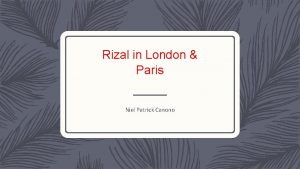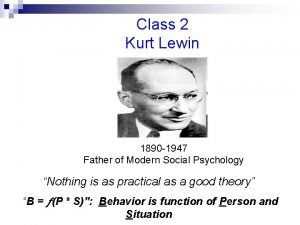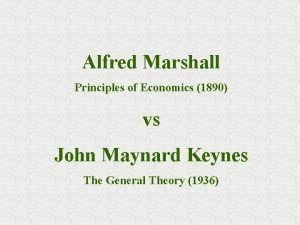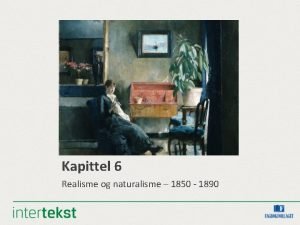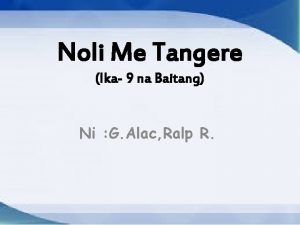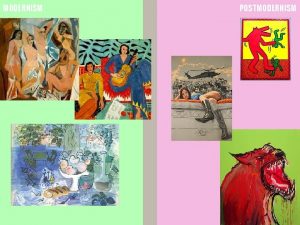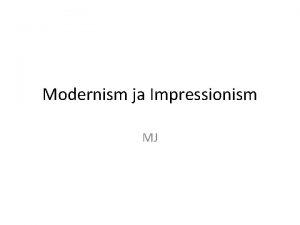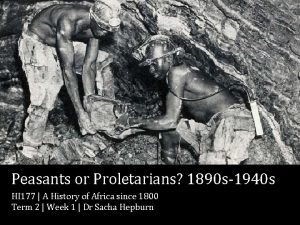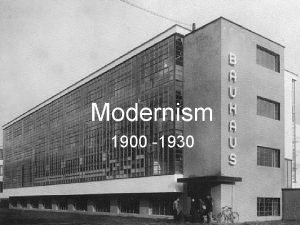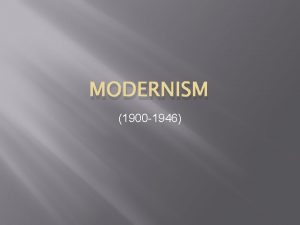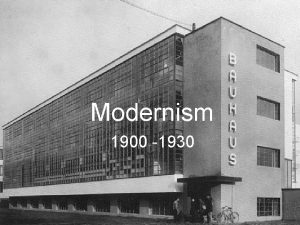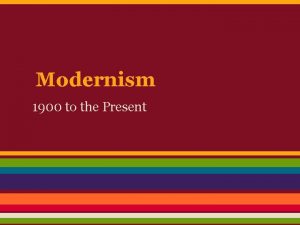ModernismPostmodernism 1900 present Modernism 1890 s1940 s v











- Slides: 11

Modernism-Postmodernism 1900 -present

Modernism 1890 s-1940 s v v Generally, modernists were driven by the belief that the assurances once provided by religion, politics, or society no longer sufficed. Intensified after The Great War (WWI) Artists had a strong sense of freedom and responsibility. Many writers believed that art had replaced religion in providing coherence, guidance, and insight into the human condition.

Modernism v Overlapped with other literary movements: – Realism – Naturalism – Harlem Renaissance

Modernism v Influences & Beliefs: – Influenced by Freud’s studies on the unconscious – Importance on the “product” rather than the “process”

Modernism v Poets – Robert Frost – Langston Hughes v Famous Modernist Authors, Poets & their works: – – The Jungle by Upton Sinclair The Great Gatsby by F. Scott Fitzgerald My Antonia by Willa Catcher The Sound and the Fury by William Faulkner

Postmodernism 1945 -present v French theorist Jean-François Lyotard succinctly defined postmodernism as "incredulity towards metanarratives” – that is, a skepticism toward the "grand narratives" that seek to explain and plot human life and history.

Postmodernism v Characterized by features such as: – a mixing of styles in the same text – discontinuity of tone, point of view, register, and logical sequence – apparently random unexpected intrusions and disruptions in the text – a self-consciousness about language and literary technique, especially concerning the use of metaphor and symbol, and the use of self-references • Stream of consciousness • Unreliable narrator

Postmodernism v Despite the often serious themes, their work often has – absurd, playful, or comic aspects – sometimes makes special use of parody • Parody-a work that imitates another work in order to ridicule, ironically comment on, or poke some affectionate fun at the work itself, the subject of the work, the author or fictional voice of the parody, or another subject. • Similar to Satire- making a serious point through humor. . . trying to change something or the way people think (i. e. The Daily Show)

Postmodernism v Influences & Beliefs: – Influenced by studies of media and language & the wide, quick-spread technology – Importance is in the “process” rather than the “product” – “Fine” art is no longer distinguished by “high” and “low” culture. • Andy Warhol, for example

Postmodernism v Poets – Lorna Dee Cervante “Freeway 280” – Martin Espada “Who Burns for the Perfection of Paper” – Diana Chang “Most Satisfied by Snow” – Simon Ortiz “Hunger in New York City” – Garrett Hongo “What For”

Postmodernism v Famous Postmodernist Authors & their Works – Catcher in the Rye by J. D. Salinger – Invisible Man by Ralph Ellison – On the Road by Jack Kerouac – To Kill a Mockingbird by Harper Lee – Slaughterhouse Five by Kurt Vonnegut – In Cold Blood by Truman Capote
 Exponential functin
Exponential functin Why did rizal choose morga?
Why did rizal choose morga? Father of social psychology
Father of social psychology Keynes marshall
Keynes marshall Agosto 6 1891 el filibusterismo
Agosto 6 1891 el filibusterismo Tradisjon og realisme på 1900-tallet
Tradisjon og realisme på 1900-tallet Africa 1890
Africa 1890 Sistema ng edukasyon sa noli me tangere
Sistema ng edukasyon sa noli me tangere 1890'lı yıllarda ingiltere'de whiff
1890'lı yıllarda ingiltere'de whiff 1890 computer
1890 computer Kirjanik 1890-1952
Kirjanik 1890-1952 Halimbawa ng referensyal na pagsulat
Halimbawa ng referensyal na pagsulat

